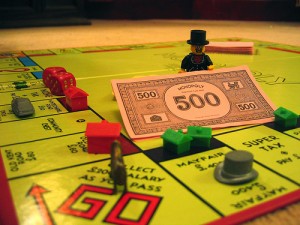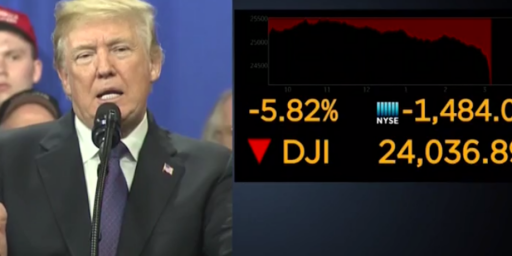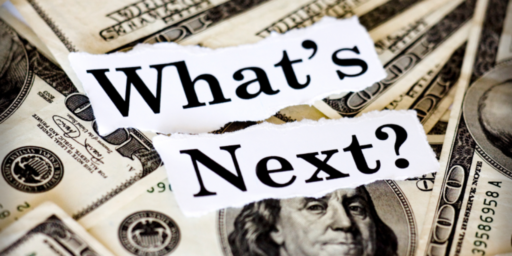The Punditry Economic Indicator
 For over a year now, we have been told consistently by the vast majority of talking heads and pundits that “things aren’t so bad” or “it’s looking up” or “the market/economy/housing market has bottomed out and will go up now” etc etc etc. Obviously, none of these things are true.
For over a year now, we have been told consistently by the vast majority of talking heads and pundits that “things aren’t so bad” or “it’s looking up” or “the market/economy/housing market has bottomed out and will go up now” etc etc etc. Obviously, none of these things are true.
For the past few weeks, though, the general consensus amongst the punditry and talking heads is that we are now heading towards economic armageddon. That the Dow is going to drop below 4000. That unemployment is going to get up to 12, maybe 15 percent. That there won’t be any recovery anytime soon–maybe not until 2011 or even later.
Now, I will freely admit that I do not have a strong knowledge base in economics beyond the basics, which is why I haven’t done a lot of commenting on the current situation or tried to make any predictions. Still, I can’t help but notice the trend of the majority of pundits being consistently wrong about the economic future. Accordingly, I can’t help but wonder if the economy is soon to turn the corner into a positive direction….
Photo by DavidDMuir under Creative Commons license.






James Joyner has been one of “it’s not so bad crowd” too. Not very confidence building in a doctor of poli sci in reading the tea leaves.
More than accuracy I think this more shows how ‘pundit/experts’ are prone to ‘group think’. Wrong or right I must agree with my fellow experts, I’ll look stupid if I disagree and get it wrong, where as if I agree and get it wrong well everyone else was fooled. Going out on a limb is risking their paychecks.
I haven’t seen the predictions of 15% unemployment. Much less consensus. Could you link?
My sense of the consensus is more like 10% unemployment, economy bottoms out over the summer, recovery in 2010. The Dow 4k talk is, as I understand it, just an extrapolation of previous lows in P/Es in recessions — at about 6-7. We’re still around 10-12 I believe.
Those could both very well be overly pessimistic.
I’m only an amateur pundit and might be lumped in with those who have been saying “it’s not so bad”. That’s a shallow reading of what I’ve been saying. What I’ve been saying is two-fold: a) it’s not so bad yet and b) talking the economy down is counter-productive.
Here’s a little table, sampled from the NBER, that gives statistics on the economic downturns in the U. S. over the last 200 years. What we’re going through continues to be less severe than the post-war average for economic downturns.
Will it get worse? It very well could. How does predicting it will get worse and acting as though it will get worse contribute substantially towards making things better?
I’m with Keynes on this. One of the things that causes downturns in the business cycle is a loss of “animal spirits”. Acting as though the end were nigh contributes materially to that process.
As has been suggested in comments below there are at least some companies seizing the opportunity of the downturn to act as though it were really much more severe than it is and, consequently, making it more severe than it was.
So I wouldn’t characterize my own view so much as either being Pollyannish or gloom and doom but more one of resolute determination.
Well, you can’t really discuss when a recovery is likely to occur until you have some consensus on what a recovery would look like. What’s the definition here? Under 5% unemployment? GDP growth in the 3% – 5% annual growth range? Some reasonable up-curve to average household income?
You can make your own suggestions, but then you have to look out there and ask yourself a) what has to happen for those things to occur, and b) how soon are any of those things likely to happen.
Personally, I’m don’t see anything positive happening within at least the next couple of years, at least – especially with the ripples of our economic problems affecting the rest of the world. If anyone thinks these things can happen sooner, I’d like to hear the argument… frankly, I could use a little hopeful news.
Slimmy: My PhD means I have some fundamental grasp of the literature as it existed circa 1993 and some aptitude for research. It ain’t a crystal ball.
My view on this has been similar to Dave Schuler’s — that talking down the economy is generally a bad idea and that the “worst since the Great Depression” talk was hardly accurate last Fall. It’s still not accurate, although we’re clearly at least in 1982 mode and possibly headed to 1970s mode. The economies of various eras are so different, though, that comparison is in some ways meaningless.
My intent on these things is mostly to talk about what we currently know and to address the proposed policy alternatives.
I continue to believe that, not only do I not know what the future holds or what impact all of the various policy measures we’re applying will have but that neither do the guys in charge. THAT’s the scary thing.
Wow, Alex. That post was somewhat skitzo. Admonishing people for not understanding how bad it is……..and then turning around and musing about a near term turnaround?
Look, this isn’t that complicated. There are four schools of thought:
“V” recession. 6-8 months. Essential thesis: last Fall’s financial debacle was a de facto contraction of the money supply. Fix the banks, this all passes and quick recovery. Like right now. As Tony Soprano might say: fuggetaboutit.
“U” recession. This would be a 1975 or 1981 style recession. 2-4 quarters of contraction (1981 was a “double dip”), totalling 3 – 4% GDP contraction. Unemployment in the 8-10% range. Need to wring out some long term and nasty excesses. There is nothing right now to suggest that this is not exactly what we are mid-way into.
“L” recession, or “The Japanese Experience.” Truncate the upside of the “U” with years and years of anemic 1% growth. I’m sure you’ve all read about it. Predicate: zombie banks and corporations, woefully indebted consumers, baby boom life cycle spending patterns on the downside. If you want to “wring your hands” worry about ineffective, politically oriented, fiscal stimulus, and failure to deal with the banks, just like the Japanese did……and where Team Obama seems headed. It could happen.
Great Depression II. Why? It made good rhetoric for passing a pork laden stimulus bill. But can someone give me the case for a 48 month peak to trough, 37%, contraction in GDP and a 25% unemployment rate?? Only if the Obama Administration is as incompetant as I supect…….wait…
I fear that I tag my posts in vain sometimes…
Drew’s taxonomy above is the one I explored in my old post linked to in my previous comment on previous post on the economy below and I’m inclined to agree with Drew’s analysis. A Japanese-style lost decade is very nearly as bad for us as Great Depression II would be for demographic reasons. It will occur precisely during what should have been the Baby Boomers’ peak earning period. I’ve been wondering for some time if that’s not one of the variables that we’re contending with.
Cramer today predicted that absolute-worst-case-if-all-the-terrible-things-in-the-world happen for the Dow is 5320. That probably puts a reasonable ceiling on it for 2009 at least. And yes, I meant ceiling.
One small quibble, Dave. The peak baby boomer earning / spending has perhaps crested: like 2008. It might, or might not be relevant. We get into the arena of false precision here.
James observed that we must allow for changing economies and dynamics, and not base our views on strict comparisons to past recessions. Perhaps the boomers will earn and spend past the age that previous generations have.
He who devines this correctly will have the raw material for out sized investment gains.
I think I’d divide your “pundit” class into a few:
– tv talking heads (and other stock touts)
– professional economists
– political commentators
Of those we can expect the touts to always find a buying opportunity. That’s easy.
The political commentators will probably choose to tell us things that show their group in a favorable light. Even if they are telling us true things, it’s natural that they’d choose a comfortable subject within the true things.
And … basically we find that the economists school together. It is a field where it is better to be safely wrong (close to the consensus) than to be wrong as an outliers.
The saddest episode in this though was when the (macro)economists split, and not along economic lines, but along the conventional lines of the Republican and Democratic parties.
Someone said “economics is politics, with numbers” and we found that to be sadly true.
The two books to bracket all this are probably Tetlock’s Expert Political Judgment and Taleb’s Black Swan.
Drew, you forgot the W-recession 😉
I don’t think that was their plan but I think it’s what’s going to happen.
Baby Boomers range in age from 46 to 62, no? 1946-1963 with most being 46 to 58. Sounds like the peak earning years to me.
Here’s one you maybe haven’t seen Alex:
“The Financial Crisis and the Systemic Failure of Academic Economics” (pdf warning)
I’ll challenge Dave and James to find “talking down” mentioned as a cause 😉
Dave –
I’ve seen 48 yrs pegged as the peak. But we are dancing on the head of a pin.
Bottom line: emerging spending momentum is not the dynamic. If anything we are reaching ending of peak.
When you find a study that finds that talking down the economy is beneficial, I’ll be more impressed.
Dave, I think you should be strong, and admit that maybe “talking down” isn’t as big in the real world as it is at OTB, rather than mail in weak responses like that one.
I’ll throw this in, because I see it as a very important indicator. The economies of scale set up around the real estate industry multiplied economic activity in ways I don’t see fully unravelling for some time, in the order of years. Banks and lenders were so highly leveraged because there was such a high demand for credit, as that demand for credit dropped we saw everyone starting to flip out about their debt, which froze the credit economy in place. The so called “animal spirits” are kicking in now and gumming up the economy. People are not going to put up with the idea of credit as we once knew it, slowing down real estate and purchasing across a broad number of industries. You can say that talking down is not a cause – it’s not, but it sure will affect the shape of the economic indicators.
I’ve stayed on the pessimistic side for some time, I’m new to the realities of how credit affects the country, but I’ve been seriously against the idea of putting down 10% and taking on a 30 year mortgage and paying 30%+ of your income, since 2006 when I even considered the housing market. It’s becoming more clear to me how much the acceptance of that idea was a serious economic driver. People don’t need a talking down, they’ve already talked themselves down and it’s reinforcing the negative effects of reduced spending. None of what is going on is confined to any small part of the economy, it’s completely spread and it’s impossible to talk up the economy until the positive fundamentals get the economy back on track, which, in the US economy, is hard to say what that really means. No one has really answered the question if the US economy can recover in an all inclusive way for everyone, it’s just assumed.
Quite frankly, the Dow dropped to 4000 would not surprise me in the slightest, and it would strike me as a sign of some sanity finally. Before you freak out at me, look at this graph:
http://home.earthlink.net/~intelligentbear/com-dow-au.htm
Today, the Dow closed at 6626.94 and Gold closed at 939.70, for a ratio of 7.05:1. Note that in previous recessions, that ratio fell to either 2:1 or 1:1 (in the case of 1981), and then normalized at between 4 and 6.
What it tells me is that the Dow/Gold ratio has probably not hit bottom yet, unless we do something to artificially postpone that normalization. Also note how much HIGHER that ratio got this time than in any previous cycle in the last century. We climbed up so preposterously high that we left ourselves a very long way to fall.
That the Dow is going to drop below 4000. That unemployment is going to get up to 12, maybe 15 percent.
If you use honest numbers, which include “discouraged” workers, we’re somewhere around 15-17% unemployment right now.
Mark Zandi, chief economist of Moody’s Economy.com:
“Q: Could there be an unanticipated bounce-back?
A: There is dark pessimism, and clearly the risks are decidedly to the downside. But there is a scenario where things turn out better than anticipated, because everything hinges on confidence, sentiment, of business, consumers and investors. And it’s possible that the policy response (bank rescues and stimulus spending) shows some progress by the summer.
markm, of course sentiment and confidence are real. On of my favorite books, for the scowling curmudgeon on the back cover, is my 1980 edition of Neill’s “The Art of Contrary Thinking.”
Crowds and their madnesses are well known.
You guys just have the tail wagging the dog a bit. You think the President controls sentiment somehow, rather than just being a player in it.
In a global economic contraction, the US President’s comments might put some daily noise in the stock markets, but they won’t make the trend. The international policy response will do that.
BTW, if you read my link above on the failure of economics, you’ll see much on the classic boom and bust cycle, and its sentiments.
BTW II, I perceive a continued reluctance by those on the “talk down” side to talk about the boom part of the cycle. I mean, you understand that irrational exuberance can be real, right? And that it can be as dangerous as irrational panic?
Because it so often leads to asset bubbles which come home to roost, sooner or later.
Charles Dow Rolls in His Grave: The Distortion of the Average He Made Famous – Friday, March 6, 2009
Have you ever asked yourself why the Dow Jones Industrial Average contains non-industrial stocks? Why such a large weighting is given to financial companies such as American Express, Bank of America, Citigroup, JP Morgan and AIG (Before its removal)? After all, you wouldn’t expect to see General Motors included in a healthcare index or Goldman Sachs in the home builders index.
The Wikipedia entry for the Dow Jones Industrial Average states that:
“The average is computed from the stock prices of 30 of the largest and most widely held public companies in the United States. The “industrial†portion of the name is largely historical—many of the 30 modern components have little to do with traditional heavy industry.â€
We do not dispute the claim that the “industrial†portion is largely historical. Indeed, there are components which have little to do with industry. Financial companies, who do not produce anything, comprise a large weighting the in this average of American Industry.
Over the last 20 years, the Dow Jones has been reshaped into a basket of 30 conglomerate corporations, with little regard for the actual business they’re in. Today’s Dow Jones would be unrecognizable to the man who created it over a century ago.
History
The index was first published in 1896 by Charles Dow, Founder of the Dow Jones Company and Wall Street Journal. Mr. Dow created and monitored a list of important industrial companies. Along with the Industrial Average, he created the Railroad Index (Transportation) which he would track along with the industrial stocks to gauge the health of the economy.
The Dow Theory was created based on the notion that both indexes should rise together in a healthy economy. The concept was a simple one. While industrial companies made the goods, the rails transported those goods to market. One couldn’t function without the other.
The original Industrial Average contained 12 industrial (Producers of goods) stocks:
– American Cotton Oil Company
– American Sugar Company
– American Tobacco Company
– Chicago Gas Company
– Distilling & Cattle Feeding Company
– General Electric
– Laclede Gas Light Company
– National Lead Company
– North American Company, (Edison) electric company
– Tennessee Coal,
– U.S. Leather Company
– United States Rubber Company
Notice that all of the companies in the index were producers of goods. There were no financial or bank stocks included in the average. At the time of his death in 1902, Charles Dow’s industrial average contained 12 stocks which were comprised of industrial producing companies such as US Steel, US Rubber, National Lead, American Car and Foundry, etc. Still no banks.
The Dow Jones Begins to Change (Era of Reganomics)
1982
80 years after the death of Charles Dow, American Express was added to the Dow Jones Industrial Average. This marked the first time that a financial stock was added to the century old index.
1988
American can, a manufacturer of tin cans merged with Commercial credit corporation and adopted the name Primerica.
1991
JP Morgan was introduced to the Dow Jones in 1991 and replaced Primerica corporation.
1997
Travelers Group was added to the index. The company would later change its name to Citigroup.
2004
AIG was added.
2008
Bank of America was added.
Reasons:
We struggle to find an explanation as to why such changes were made. Was it because America became de-industrialized over the last quarter century? Was it merely a reflection of big business today? With companies such as General Motors and General Electric playing dominant roles in non-core businesses such as finance and banking? Or were these financial stocks added to the index in hopes of propping up its value with companies such as JP Morgan and AIG, whose earning power seemed indestructible? Our hunch is that it was a combination of each. (More at the link.)
http://www.chartingstocks.net/2009/03/charles-dow-rolls-in-his-grave-the-distortion-of-the-average-he-made-famous/
I agree, for the stock market, 3500-3700 as a low is my prediction.
Unemployment, 12 to 15 percent sounds about right.
With Socialist’s in charge of this country.
With politicians, who are more Socialists than free market advocates, we will probably undergo a FDR type recovery, if one at all. It will take a citizen’s revolt, not a world war to get us out of this.
Not in any conventional sense of the word, no. We have “private profits, socialized losses.”
That doesn’t break along party, or even authentic philosophical, lines. Instead we have billionaire players who are able take money while things are good, but bring their buddies in to bail them out when things get bad.
The proof that this isn’t partisan is that the same “socialized losses” profile spans the Bush and Obama years (so far!).